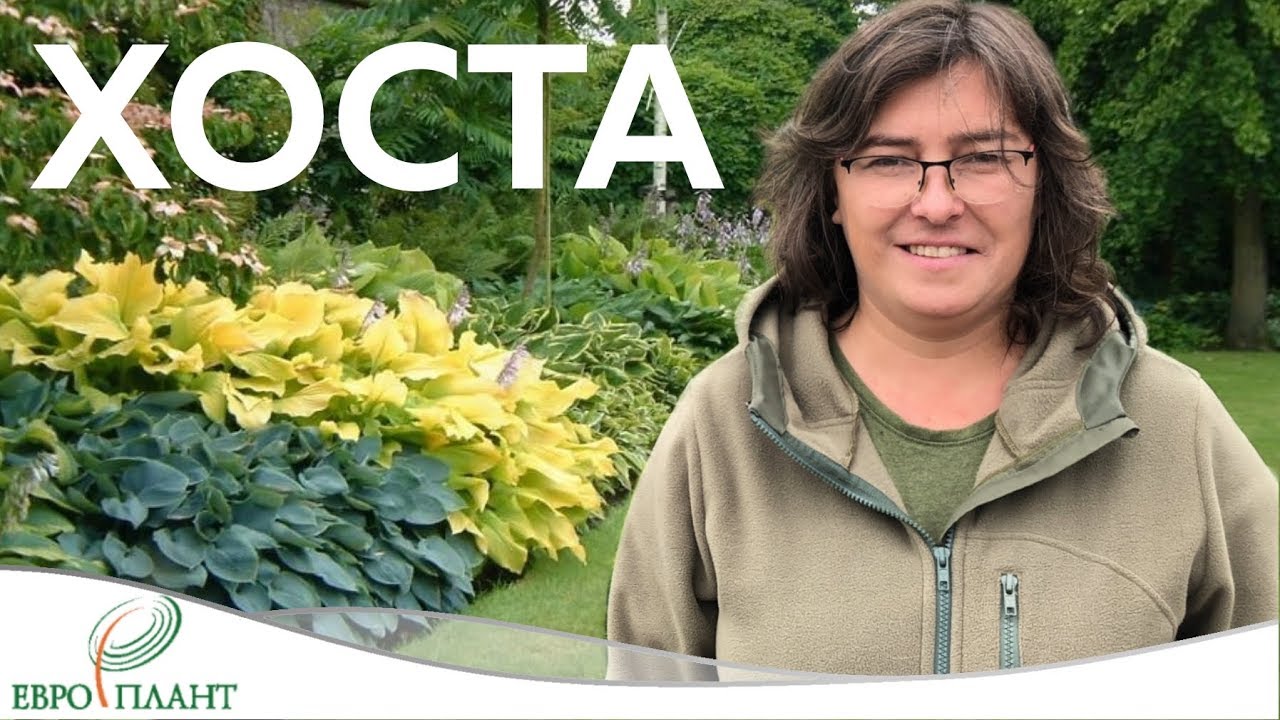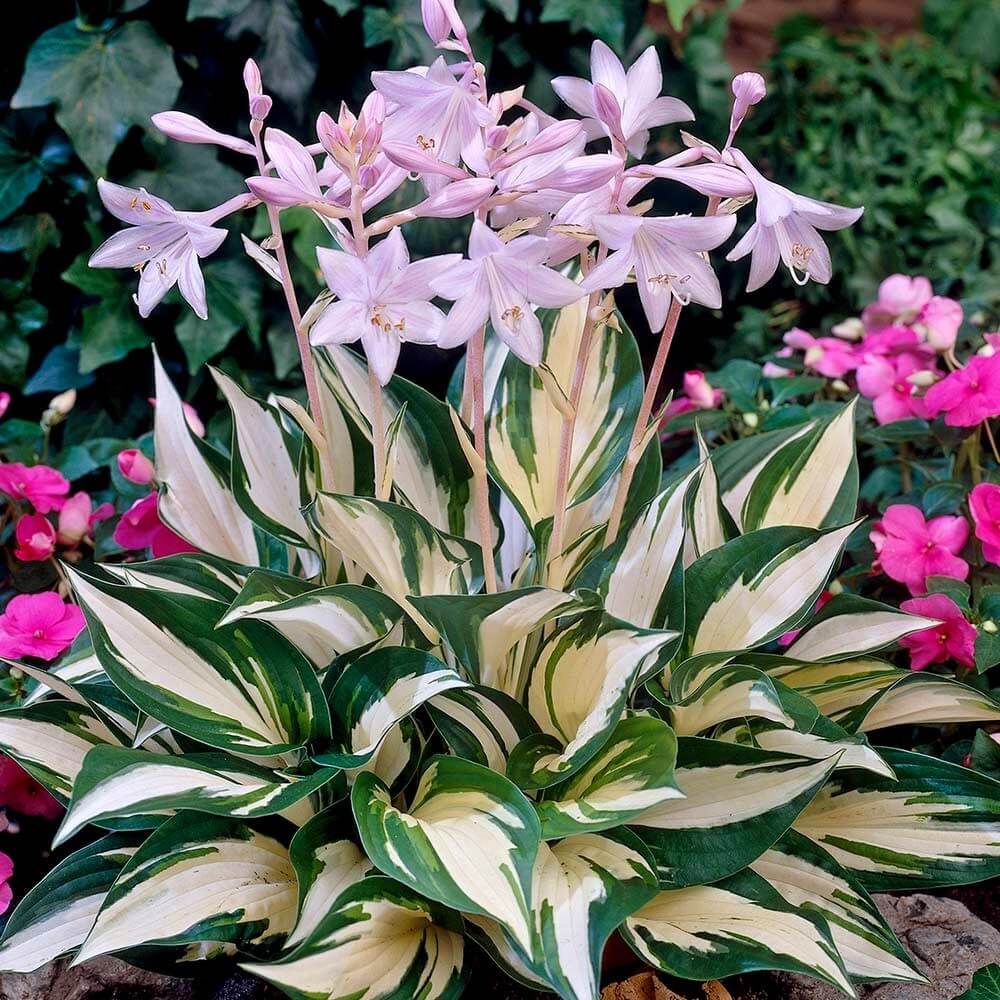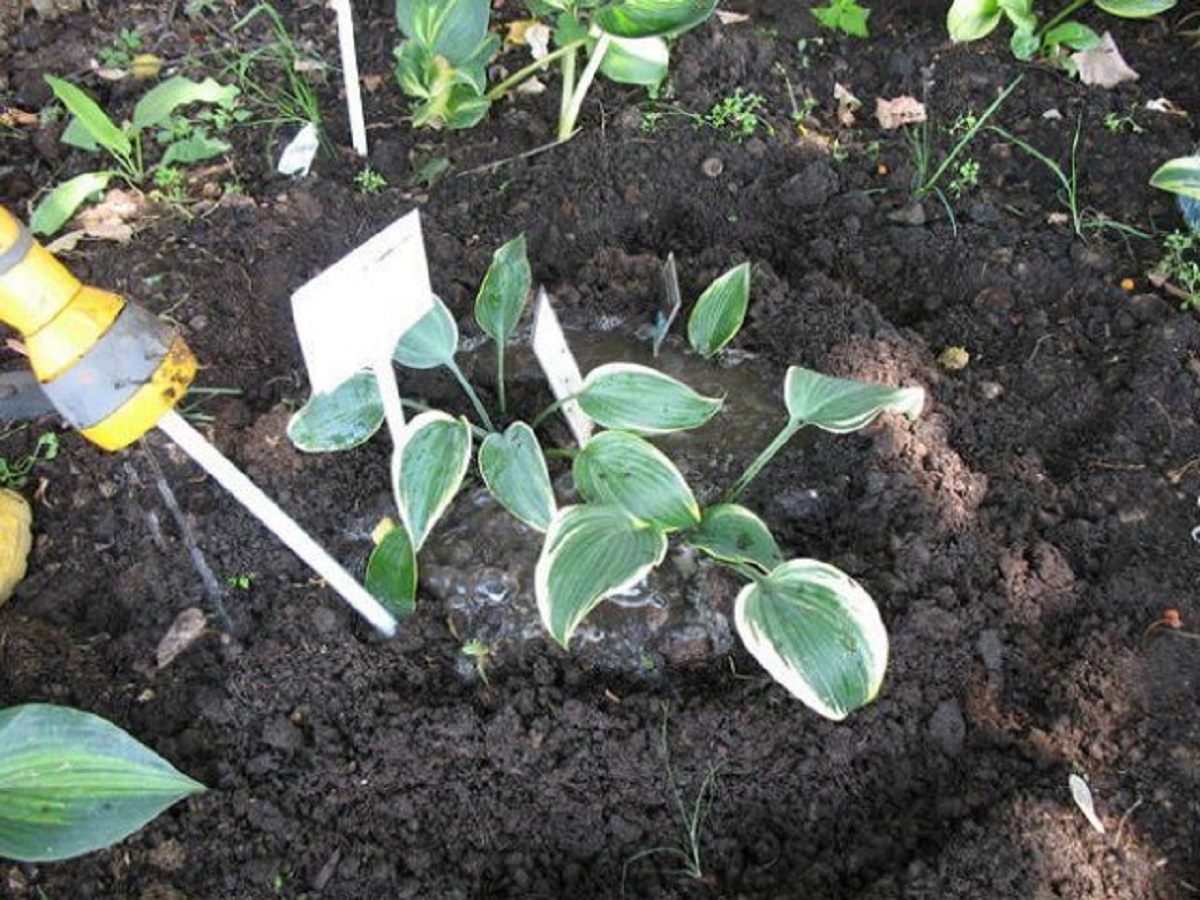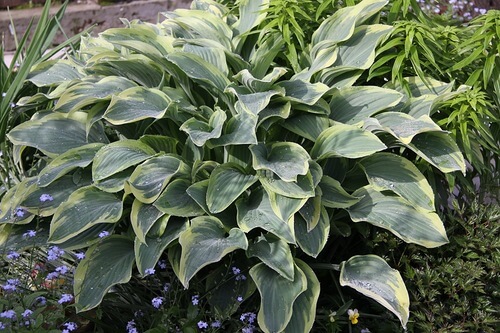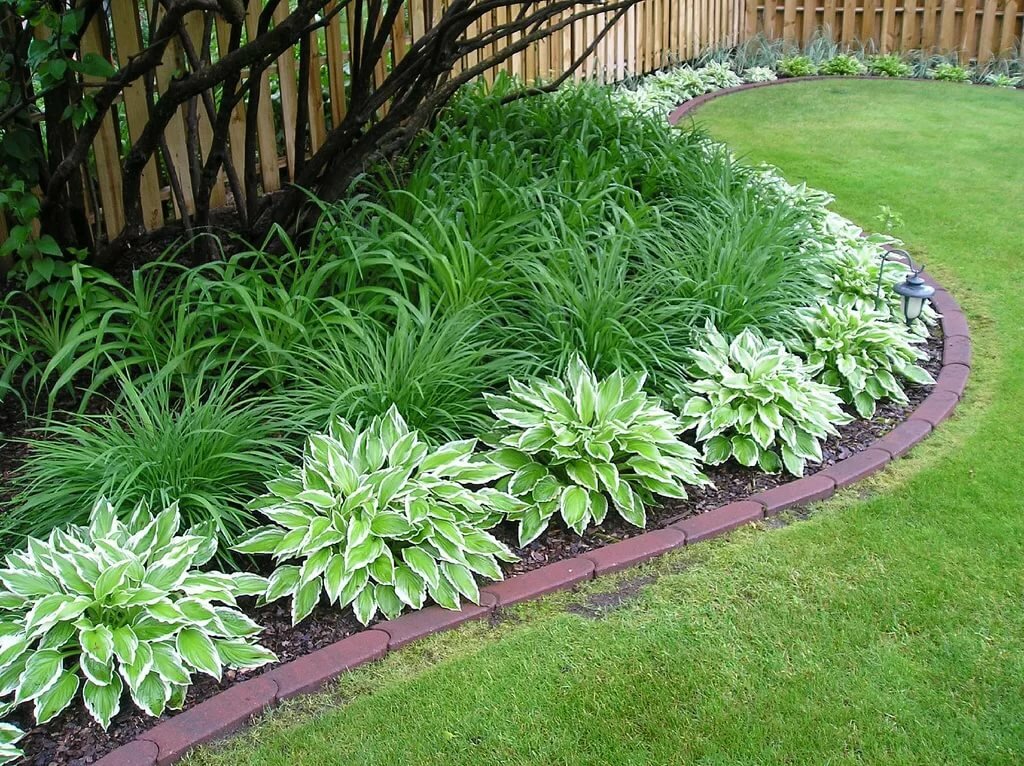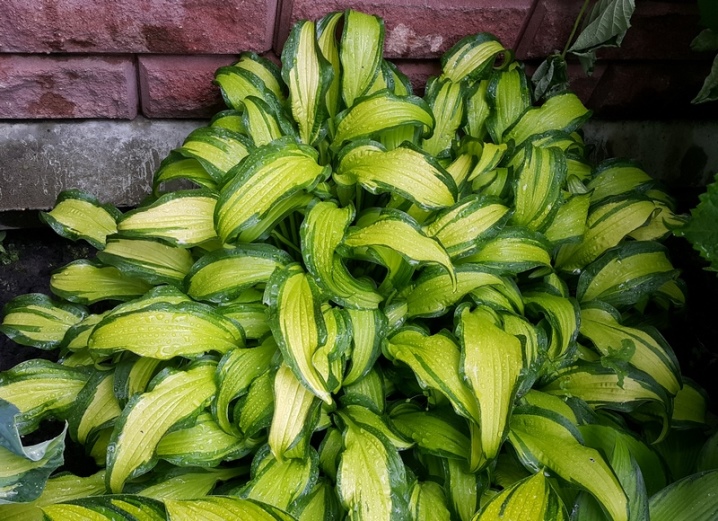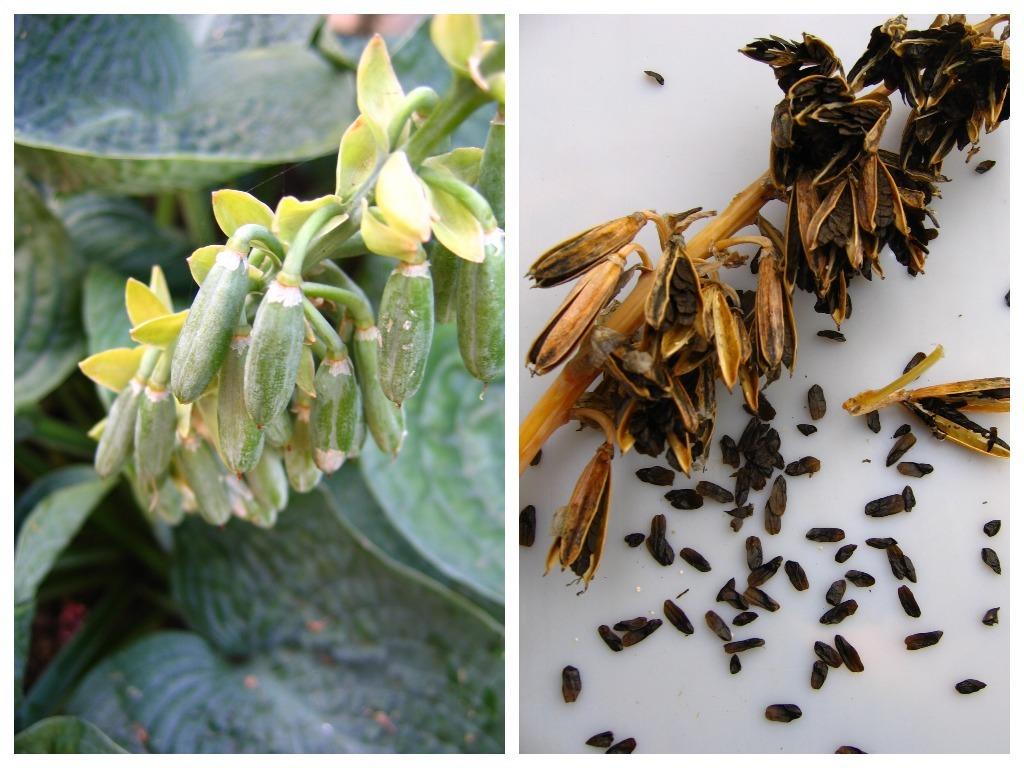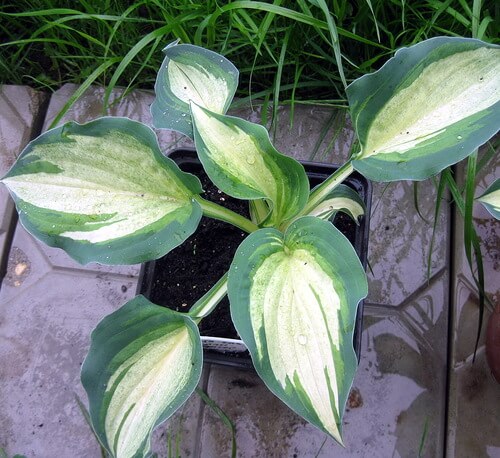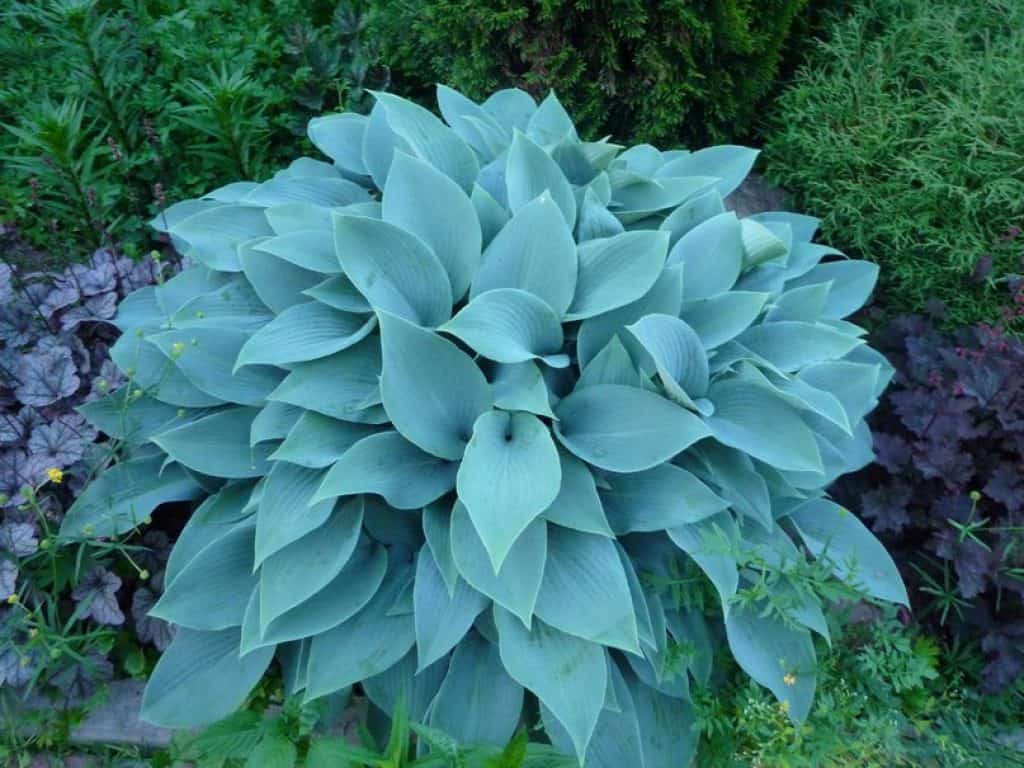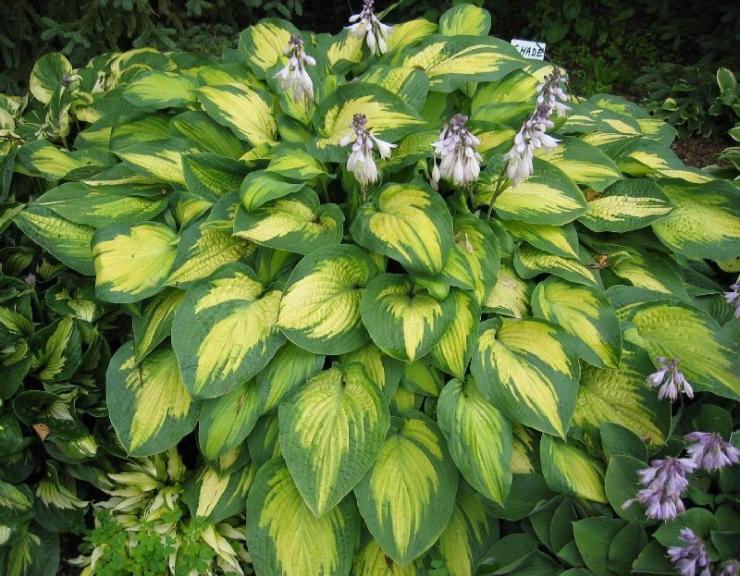Useful videos
Hosta Halcyon - One of the bluest hosts. The leaves are very dense, spear-shaped. Lavender flowers are large, funnel-shaped.
Description of the Halcyon Host. Medium-sized leaf - 16 x 10 cm. Shrub up to 50 cm. Flowering period June-July. Winter hardiness zone: 3 (-40 ° С)
Hosta, or funkiya, is a perennial herb of the Liliaceae family. The hosts are home to China and Japan. It is an ornamental deciduous perennial. Hosta leaves are about 20 cm long, up to 10 cm wide, located on petioles and form a large basal rosette. They can have various shapes and colors, be monochromatic or with edging, with or without a wax coating, with a straight or wavy edge. The flowering stems are glabrous, from 20 to 100 cm high. The flowers are bell-shaped or funnel-shaped, blue, lilac or white, collected in racemose inflorescences. Hosta blooms in July-August.
Landing site for Host Halcyon. Hosts can grow in both shade and sun, but most of them prefer slightly shaded areas. Variegated species are more light-loving. Plants need protection from drafts and strong winds. The soil for the host is suitable for fertile, moist enough, but without stagnant water.
Landing Host Halcyon. Before landing, the hosts dig up a plot of 1 sq.m. add a bucket of humus and a complete mineral fertilizer. Small holes are dug at a distance of 30-50 cm from each other, corresponding to the size of the root system. Drainage is laid at the bottom, garden soil is poured, rhizomes are placed, spreading the roots, and covered with garden soil on top. The soil is compacted, well watered, planting is mulched.
Host Halcyon care. The hosts do not need special care. Plants must be watered in a timely manner, weed out, fed with organic matter or mineral fertilizers. An excellent technique is the surface mulching of the soil with humus, it allows you to retain moisture and creates favorable soil conditions for the plant. In autumn, the hosts are not pruned, only the peduncles are removed. They also do not need shelter for the winter, the culture tolerates frosts down to -40 ° C.
Reproduction of the Host Halcyon. Propagated by host separation of the bush and cuttings. Adult shrubs are divided in early spring (before early May) or autumn (in September). To do this, the plant is abundantly watered, dug up and divided into several parts, so that each of them has 1-2 leaf sockets. The resulting cuttings are immediately planted in a permanent place. Hosta cuttings can be carried out throughout the summer. To do this, young shoots with a heel are separated from the plant, the leaves are cut by a third, planted in a shady place, covered with a plastic bottle. In the first days, the leaves will lie on the ground - the turgor is lost, but after a couple of weeks the cuttings will take root.
Using Halcyon Host in garden design. Hosta is great for landing along the shore of a reservoir, for rocky gardens, mixborders, planting along paths. It looks impressively planted in groups against the background of an emerald lawn. Ornamental hosta leaves are widely used to create bouquets.
They are located on high peduncles above dense foliage, which gives the impression of exquisite bouquets.
Hosta halcyon is a hybrid variety of tardiflora x sieboldiana “Elegans, which has the second name“ Calm ”. A short shrub about 50 cm tall with bluish-gray foliage, covered with a thin, very persistent, indelible silvery waxy coating that helps the plant retain moisture. It simultaneously decorates the bush and serves as protection from the sun's rays, unintentional mechanical damage to the leaves. This variety is an excellent representative of the blue host group, growing excellently, retains the color of the leaves well throughout the season.
Features of agricultural technology
Meadows hosts are unpretentious and grow anywhere in the garden. A dry slope, a wet lowland, and an area under trees are suitable.
The choice of location is determined by the color of the foliage. For Hosta Golden, a place with partial shade is suitable, for example, in the shade of trees, since it needs a little sunlight to acquire a beautiful golden color. If there is no moderately shaded area, then place the hosta on the west or north side of other large flowers. It is watered a lot, the soil is mulched with compost.
When planting, you must adhere to the recommended depth. The root collar should be 4 to 5 centimeters deep. Otherwise, on the one hand, the roots will begin to rot, on the other, they will be pushed to the surface.
This is a plant with large dimensions and leaves. A lot of moisture constantly evaporates from it. The soil must be moistened so that large and lush leaves will grow. It is especially necessary to water the young growth. To prevent the soil from becoming very compacted, water should be watered with a jet with a medium pressure. The soil should be soaked 10-15 centimeters. Watering is carried out either in the morning or in the evening. In sandy areas, the hostu is watered every day. If there is a lack of moisture, darkening will appear on the tips of the leaves.
Soil for Meadows:
- Nutritious neutral;
- Slightly acidic.
Compost and sand will have to be added to heavy clay soil, peat and leaf humus to dry and loose soil.
Growing in pots
It is undesirable to replant adult bushes that have been growing for more than 10 years. This can negatively affect them. If a transplant is needed, then they do it in the spring or in late August - early September. Water the seedling 20-30 minutes before placing it in the ground. Leave a distance of 30-40 cm between the bushes. Water for two weeks daily.
Organic fertilizers are added as a subcrust: humus and compost, and during planting, a complex of minerals is poured into the pit. In acidic soils, PH is normalized with dolomite flour or ash. Mulch with humus, mown grass, semi-decomposed sawdust. In autumn, such procedures are carried out to protect against frost when there is no snow.
Of mineral fertilizers, potassium, phosphorus and nitrogen are used in a ratio of 1: 2: 1. The first top dressing is in April (the beginning of leaf growth), the second - after 6 weeks, at the end of May, the final one - in July.
On a note. Flower arrows need to be broken off for an attractive appearance, as they break the symmetry of the bush. You can wait for the flowers to dry and remove them.
It is necessary to cut off shoots with buds after flowering, apply fertilizers by the end of July, cover the ground with mulch and add tobacco dust from pests there, treat with fungicides (Fitosporin), cover with dry branches. Film, roofing felt and other poorly permeable materials cannot be used for insulation.
Important! If after winter shoots do not appear for a long time, do not be afraid. The host may be late in germination, as it will expect constant heat.
Reproduction:
- Seeds. It is difficult to germinate the hosta in this way, so gardeners do not recommend it. With this reproduction, the plant will become decorative only by the age of 4.
- Division of the bush. The rhizome can be successfully divided throughout the season, but is best done in spring and early fall. To reduce evaporation, part of the leaves must be removed. The separated part is planted and watered. Young leaves will appear soon.
- Cuttings. When dividing the bush, stem cuttings are formed. Part of the roots with a bud are placed in a greenhouse. After a short time, they grow up.
How to care?
Hosta Golden meadows is a fairly large plant. Accordingly, a significant amount of moisture evaporates from the surface of the leaves.
Strong soil compaction is undesirable. Therefore, the water pressure during irrigation should not be too strong. You need to saturate the soil by 10-15 centimeters. The procedure is carried out in the evening and morning hours. If the soil is sandy, watering is carried out daily. The plant can itself signal a lack of moisture.It manifests itself in darkening at the tips of the leaves.
Transplantation deserves special attention.
In exceptional cases, the procedure should be carried out in late summer or early autumn.
The seedling is watered half an hour before it is placed in the planting hole. The distance between them should be approximately 30-40 centimeters. Daily watering is recommended for the first 2 weeks after planting.
Top dressing should not be ignored either. Hosta Golden Meadows loves organic fertilizers. Compost and humus work well. When planting in a hole, it is recommended to add mineral complexes. Gardeners most often use potassium and nitrogen in equal proportions, equal to the same amount of phosphorus.
If the soil is acidic, it should be normalized. Ash or dolomite flour is perfect for this. Mulching is best done with cut grass, humus and rotten sawdust. This is especially important in the fall to protect the plant from the coming cold weather in the absence of snow.
It should be noted that the flower arrows do not look very pretty. For this reason, they need to be broken off so that the symmetry of the hosts is preserved. It is best to remove the flowers after they have dried.
After the hosta has faded, the shoots with buds are removed. Top dressing is applied until the end of July, after which the soil is mulched. To prevent the invasion of pests, you should treat the area with fungicides and tobacco dust, and put dry branches on top. Germination of seedlings may be delayed - this is normal, as they are waiting for constant heat.
Care
Golden Meadows is an unpretentious function that is not afraid of droughts and cold. However, it does not tolerate waterlogging, although it needs moderate soil moisture. For better decorativeness, the host needs to be fed, and cut off in the middle of autumn.

Hosta Golden Meadows
Watering
Water the hosta 2-3 times a week, focusing on the condition of the soil. The soil should be moderately moist, but not turn into a stagnant "swamp". Watering is best done in the morning (before 11 o'clock), directing the stream to the root, and not to the leaves. Usually 1-3 buckets of water are used for one bush.
Top dressing
Organics laid down during planting will provide the function with nutrients for the entire season. In autumn, it must be mulched with peat or compost, and in early spring, repeat the procedure. In addition to organic fertilizers, you can use mineral complexes - in April and before flowering.
Pruning and preparing for winter
Faded flower stalks are cut to maintain the decorative shape of the funkia. With the onset of autumn cold weather and yellowing of the leaves, the entire ground part of the bush is cut off. This creates a good prevention of pests and diseases.
Reproduction
Cuttings
This is not the most popular method for poorly growing bushes or plants with rotten roots.

Hosta Golden Tiara Description
For planting, you will need a stalk torn off with a heel or several roots without digging out the rhizome.
On the shoot, the leaves are shortened by half the length. They are planted in open ground or under a greenhouse in a mixture of peat and sand. Moisturize, shade from the scorching sun every day.
As soon as new leaves appear on the handle, it can be considered that the reproduction was successful. They continue to look after adult plants.
By dividing the bush
In the spring, when warmth comes, the bush is watered, dug up, washed under water to wash off the remnants of the soil. Then cut with a shovel or knife into pieces so that each has roots and at least one bud.
Places of cuts are sprinkled with charcoal, after drying, they are seated separately.
Seeds
This method is not very effective and is rarely used by gardeners. In addition, it is difficult to provide seedlings with proper care at home, and they reach their maximum decorative effect only at the 4th year of life.
Such breeding is more used in industrial horticulture to develop new varieties and hybrids.
How to reproduce?
There are several ways to propagate the Golden Meadows host. Among them are cuttings, dividing the bush and propagation using seeds. Let's consider each in more detail.
The most difficult to propagate a plant with the latter method. Gardeners use this method least often. The decorative function will only be achieved at the age of 4 years.


Reproduction by dividing the bush is carried out more quickly. It is recommended to carry out the procedure in the spring or at the very beginning of autumn, but this is not a prerequisite. To reduce evaporation, some of the leaves should be removed. Part of the bush is separated, planted separately and watered. Young leaves should appear soon.
Dividing the bush leads to the formation of stem cuttings. A small part of the root system (with the obligatory presence of a bud) should be placed in a greenhouse. In such conditions, the cuttings will grow rather quickly.
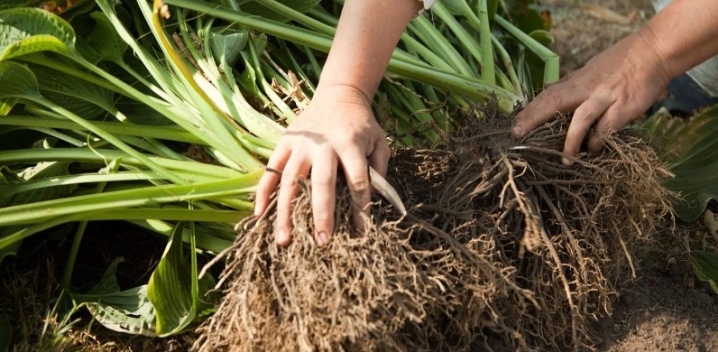
Care requirements
Taking care of the hosta is not difficult, all she needs is regular moisturizing, loosening and feeding.

Hosta golden tiara
Watering
Watering often, because in moist soil, the leaves develop larger and more juicy than in overdried.
Frequency during the growing season - once every 3-4 days, provided that the summer is dry and hot.
They use settled and warm water - 5 liters are enough for one bush. The next day after watering, the soil is loosened, weeds are removed, mulch is applied from peat or compost.
Top dressing
Starting at three years old, fertilize according to the following scheme:
- in the spring (in April and in May), a mineral dressing containing nitrogen, phosphorus and potassium is introduced - 1 tbsp each. l. for 10 liters of water;
- in the summer they are fed with superphosphate and potassium sulfate - 15 g per bucket of water;
- in the fall, leaf compost or peat is covered up in the near-trunk circle.
All fertilizers are combined with irrigation to improve the quality of nutrient absorption.
Pruning
From spring to autumn, yellowed, dried and withered leaves are removed from the crown to prevent infection with diseases and pests.
Also cut the flower arrows to the base. After cutting, you can process the crown with Epin and Zircon so that the hosta recovers faster.
Preparing for winter
A week before the coming cold weather, all the foliage is cut out, the rest of the shrub is sprinkled with a thick layer of peat, sawdust.
Diseases and pests
The host is usually not affected by almost anything, except, perhaps, slugs, which are dangerous for varieties with thin delicate foliage. These molluscs sprinkle holes in the sheets of sheets overnight, and to prevent this, specialized agents, such as a slug eater or a thunderstorm, are scattered over the surface of the earth.
Rarely, but still, the hosta can be attacked by the black weevil. In this case, yellowing and wilting of the foliage occurs. Similar symptoms accompany infection with X or HVX viruses (yellow ring-shaped spots are formed). In both cases, diseased plants must be removed from the site.
If the hosta has stopped growing, and its leaves brighten and die off, then we are talking about rot of the root collar. The very first signs of the disease indicate the need to dig up the affected bushes and cut out the damaged tissue. The wounds formed on the rhizome should be sprinkled with fungicides, and the cured bush should be planted in another area. It is also recommended to replace the soil at the old place.
In hosts, foliage may dry out due to rust disease. This ailment is more characteristic of the yellow-bordered host. It is a consequence of dehydration of leaf tissues in hot and dry weather, therefore host varieties of this group are planted only in shaded areas and watered abundantly in dry times.
Hosta Gold Standard
Not all plants can grow in the shade; the hosta is rightfully considered the queen of such crops. Decorative variegated leaves and exotic flowers of the Gold Standard variety will not leave indifferent any grower.
Description of culture
Hosta is a genus of perennials from the Asparagus family. They are popular among flower growers because of the shade tolerance and decorativeness of the leaves.The leaves of this culture come in a variety of shapes and colors. 23 species and almost 600 varieties of this plant have been registered.
Hosta Gold Standard is one of the most common varieties. It was bred in 1976 in Michigan on the basis of Hosta Fortunei, so many people use the full name of this variety - the Fortune Gold Standard host. This culture is versatile to use. Suitable for planting around trees, for alpine slides, for creating borders, many growers plant it around water bodies.
Hosta Gold Standard
Features of the variety
The leaves of the Gold hosta are ovoid. This variety blooms from July to August. Flowers - lilac, located on long peduncles (up to 1 m, several pieces). At the end of flowering, capsules with seeds are formed (the brown color of the capsule indicates the ripening of the seeds).
Hosta Golden Standard is painted in a pale green color in spring with a dark border along the edges of the leaf, from the beginning of July the middle of the leaves turns golden, the border remains dark green. The hosta Gold Standard can grow up to 70 cm in height and up to 120 cm in diameter.
Note! Hosta Gold Standard is a winter-hardy variety, it does not need to be covered for the winter
Features of agricultural technology
Of all the host, this variety is not only shade-tolerant, but also photophilous, i.e. prefers partial shade. It is desirable that the sun warms the plant in the morning, preferably in the morning.
Interesting! In bright light, the plant changes color: the golden color of the leaves turns white.
The soil for planting should be well-drained, neutral, moist. In dry summers, the plant needs moderate watering, and also responds well to fertilization. Top dressing has a positive effect on foliage growth. You need to feed with organic matter or mineral fertilizers, and it is best to alternate them.
You need to fertilize three times per season:
- Before flowering.
- During flowering.
- After him.
Important! The soil around the hosta needs to be loosened periodically. Loosening is carried out carefully so as not to damage the roots of the plant
Planting a seedling of this culture should be done in spring or early autumn, so that the young plant has time to root before the upcoming wintering. Planting material should be selected only in proven nurseries.
Sapling planting rules:
- dig a wide hole, because the roots grow in breadth, about 30 cm deep;
- pour soil from the site, peat and sand in equal proportions into the hole, filling in about 2/3 of the hole;
- spill a hole with water;
- spread the roots of the seedling about the surface of the soil, cover them and water again;
- mulch the soil around the plant with a layer of 2 cm.
Hosta Gold Standard
Culture propagates in 3 ways:
This culture is not susceptible to diseases, but pests can attack it, especially slugs. The danger of these molluscs is that they feed on the leaves of the plant and the host loses its decorative appeal. Slugs can be fought by mulching with a sharp material such as broken shells.
Benefits of the variety
This culture has characteristic advantages:
- easy care;
- frost-hardy and winter-hardy variety;
- not susceptible to disease;
- high decorativeness;
- versatile in use.
The host of this variety is a beautiful and original plant that does not require much care, but at the same time will decorate the backyard with its exotic look.
Breeding methods for Golden Meadows hosts
Dilute host can be at home... For this, it is advisable to work with relatively mature plants (3-5 years old). The main breeding methods are:
- dividing the bush;
- growing from seeds;
- grafting.
The simplest of these is to divide the bush. You can dilute the host in this way at any warm season - for example, in spring, summer or autumn (a month before the first frost). The sequence of actions is as follows:
- Dig in the ground with a sharp shovel within a radius of 35 cm from the center of the hosta (diameter, respectively, 70 cm).
- Cut out the ground along with the bush.
- Gently detangle the root hairs, rinse off the soil if necessary.
- Cut with a knife into several divisions (each of them should have 2-3 sprouts).
- Transplant into soil with a similar composition and approximately the same depth at which the mother plant grows.
Important! For the winter, it is better to cover the delenki with mulch. This is optional in the south.
They can be immediately planted in a permanent place, observing an interval of at least 50 cm.
Top dressing hosts
Hosts, which are mostly large plants, require good organic fertilizers such as humus and compost to maintain a high decorative effect. The second is fertilized with the soil in the pit during planting, sometimes with the addition of complex mineral fertilizers. Dolomite flour or ash should be added to acidic soil.
Regarding mulching, it is worth noting that in the spring it is better to perform it using, for example, humus, mowed grass or semi-decomposed sawdust, and in the fall it will be convenient to repeat it to protect the plant from frost during snowless cold periods.
Mineral fertilizers for the host are selected on the basis of nitrogen, phosphorus and potassium (the store mix on the package contains the designation “NPK”) in an equal ratio or 1: 2: 1. For the first application, the time of the beginning of leaf regrowth is chosen, often in April, the second mineral dressing is carried out 6 weeks later - at the end of May, and the final third - in July.
Variety characteristics
Description
Leaves are dense and tough, large, wavy at the edges, similar to terry. Color - gray-green with a creamy core. The border is wide feathery, blue in color. The center of the leaf plate in the spring is golden, in the middle of summer it is creamy, then it begins to turn green.
The originality lies in the twisted leaves and the change in color of the leaves at different periods of the season. The shape of the leaf is round, the size is 23 by 15 centimeters. The plant is powerful, reaching 60 cm in height. It grows gradually.
Location and lighting
The variety loves partial shade. The scorching rays can burn out the core. In a space that is too dark, it can turn completely green. In nature, hosts grow in river and lake valleys, on mountain slopes and forest edges.
The variety loves partial shade
Bloom
Occurs in July. The buds are like bells or little lilies. At the end of a long process, many flowers bloom.



